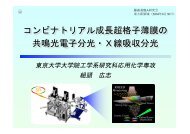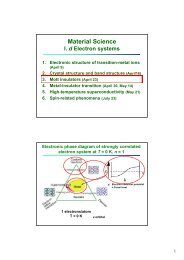Thesis High-Resolution Photoemission Study of Kondo Insulators ...
Thesis High-Resolution Photoemission Study of Kondo Insulators ...
Thesis High-Resolution Photoemission Study of Kondo Insulators ...
You also want an ePaper? Increase the reach of your titles
YUMPU automatically turns print PDFs into web optimized ePapers that Google loves.
7.3. Results and Discussion 101<br />
light source we used the He I resonance line (hν = 21.2 eV). The samples were repeatedly<br />
scraped in an ultra-high vacuum with a diamond file to obtain fresh surfaces. The<br />
base pressure <strong>of</strong> the spectrometer was in the 10−11 Torr range. The Fermi edge <strong>of</strong> Au<br />
film evaporated on the sample surface after each series <strong>of</strong> measurements was used to<br />
determine EF and the instrumental resolution. The resolution thus determined was ∼<br />
20 meV.<br />
7.3 Results and Discussion<br />
Intensity<br />
FeSi<br />
297 K<br />
225 K<br />
150 K<br />
75 K<br />
18 K<br />
Fe 0.95Co 0.05Si<br />
Fe 0.90Co 0.10Si<br />
18 K<br />
18 K<br />
hν = 21.2 eV<br />
-10 -8 -6 -4 -2 0<br />
Energy relative to E F (eV)<br />
Figure 7.3: Entire valence-band photoemission spectra <strong>of</strong> Fe1−xCoxSi taken with hν =<br />
21.2 eV.<br />
Figure 7.3 shows the entire valence band <strong>of</strong> Fe1−xCoxSi. As already reported [7.6,<br />
7], the temperature dependence <strong>of</strong> the photoemission spectra <strong>of</strong> FeSi in such a wide<br />
energy scale is negligible. Also, Fig. 7.3 shows that the spectra do not change for






